The first Brazilian modern Battleship: The ironclad Riachuelo was one of the main reasons which pushed the Congress, at the insistence of the USN admiralty, to built battleships, notably the USS Texas. At that time indeed, a naval rivalry between south American countries pushed Brazil, Argentina and Chile to order ships to British yards. The Riachuelo was no exception, a 5900 tonnes vessel from Samuda Bros. intended to take the lead of the pack in the 1880s. She was later joined by Aquidabã, under the patronage of Admiral Jose Rodrigues de Lima Duarte, minister of the Navy.
As a minister, he presented a report to the national legislature on the importance of modernising the Brazilian Navy.
As local shipyards were unable to deliver complex vessels such as ironclads, a delegation was to be sent in Great Britain to order two modern ironclads.
Prior to this, the Brazilian navy had ironclads and armoured ships in service: The most recent were the coastal monitors of the Javary class (1874) built in France, the locally built (Rio) Sete of Setembro (1874), the Cabral class and the Mariz e Barros class (all built in Rennie, 1866), the Silvado (France, 1866), Bahia (Laird, 1865), Rio de Jaineiro (1865), Lima Barros class (Laird-built 1865), Tamandaré (UK? 1865), Brasil (La Seyne, 1865), and Barrozo (UK? 1864). The Riachuelo was the first modern sea-going Brazilian battleship, in the same vein as the Sachsen or Dingyuan class.
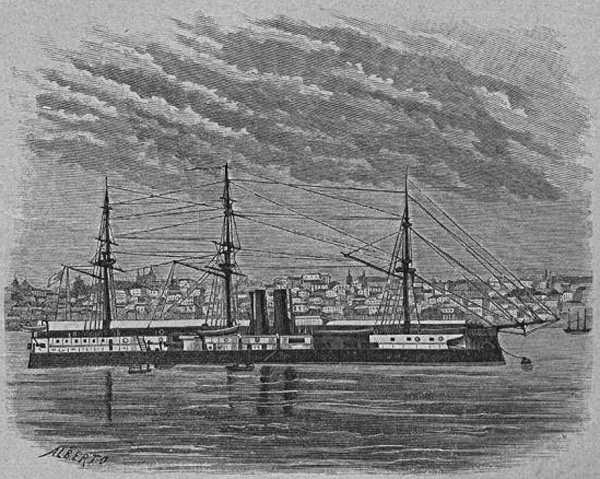
Riachuelo in full rigging, engraving in the 1880s as delivered.
Design of the Riachuelo
The Riachuelo was typical of these late 1880s ironclads, with a twin pairs of main guns in barbettes positioned in échelon and armoured all around. Due to budget constraints however, the main armament was limited to 9.2-inch (234 mm) guns under enclosed Coles-type turrets. There was a secondary battery six 5.5-inch (140 mm) and tertiary light artillery against Torpeod boats. This was all modified during her 1894 refit in France.
The Riachuelo and Aquidabã had an artillery arrangement quite popular in the 1870s and 1880s: Two main gun turrets off the centreline, en echelon. Through this, the forward turret was placed offset to port and the aft turret to starboard. The superstructure was taller than both turrets, with gangways above them, running the whole ship’s lenght. The Riachuelo’s silhouette was completed with two funnels and three fully rigged masts.
Aquidabã was slighty smaller (4920 tonnes, 85 m long) and had just one funnel. She was built in the same yard at Samuda Bros but launched two years later in 1885.
Riachuelo’s displacement standard, was 5,029 tons, and according to Conway’s* 5610 standard and 6100 tonnes fully loaded. She measured 93.33 m/92.96 m (306.2 ft or 305 ft pp), for 17.16 m/15,85 m (56.3 ft or 52 ft) wide with a draught of 5.60 m/5.99 m (18.4 ft or 19 ft 8 in).
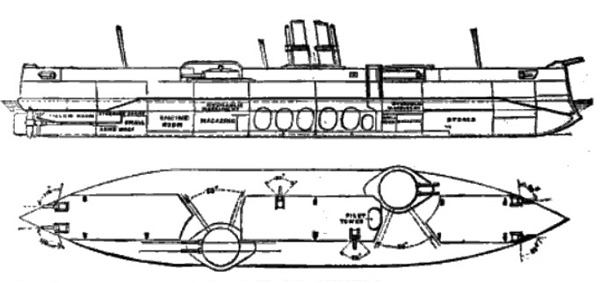
Blueprint of the ship
Propulsion
She was a mixed vessels, as common at that time, with sailing and steam combined. In sailing mode, she had three masts arranged in a barque configuration. The steam engines were three-cylinder vertical compound machines, fed by height cylindrical coal-fired boilers, and the power was passed onto two shafts. Total output was 4,500 hp (3.36 kW). The top speed as designed was 16.5 knots (30.56 km/h). The onboard coal supply allowed for a 6,000 nmi (11,000 km) range at 10 kn (19 km/h).
Armament
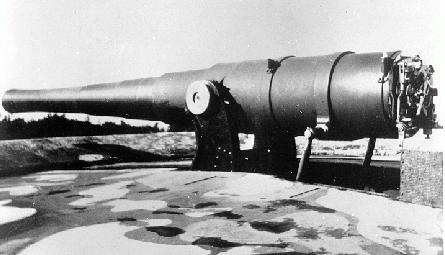
Riachuelo’s main armament comprised four 9.2-inch (234 mm) guns in two Coles type turrets (cheesebox style). The BL 9.2-inch Mk I was designed in 1879 as a request by the Admiralty for a response to Krupp’s 24 cm (9.45 inch) gun. The Admiralty was interested and requested it to the Committee on Ordnance as considering the return to breech-loading artillery after experimenting with muzzle-loaders in the 1860s-1870s.
The new gun fired a 380-pound projectile and a total of 19 Mk I and Mk II guns/26 calibres were manufactured by Vickers, starting in 1881. However the Navy declined the model and the Mk-I/II never made it at sea but instead in coastal defence. The Mark III was the main naval model, 24 tons, 31.5 calibres. It was declined into the IV, V, VI and VII versions as well and produced in large quantities, making it in cruisers such as the Imperieuse, Orlando, Blake, Edgar class armoured cruisers, rearmed monitors and WW1 monitors. It looked relatively weak for a battleship though, but it is believed the overall budget, limitations in size of the ship, and rate of fire were critical.
The shell’s weight varied from 380 pounds (172.37 kg) to 290 pounds (131.54 kg), muzzle velocity 2,065 feet per second (629 m/s) and maximum range around 10,000 yards (9,100 m) at max elevation.
It should be noted that the Portuguese source is completely different about the armament: Four 225 mm main guns, four 140 mm guns, eleven 25 mm and five 11 machine guns.
Secondary armament: Six 5.5-inch (140 mm) guns. No precision of their origin. The only BL 5.5-inch Mk I naval gun in service with the RN dated back from 1913. It is more likely to be a BL 5-inch gun Mk I/II, as no British yard would accept to mount Krupp guns, and there was no French gun of this caliber either.
Tertiary armament: Fifteen 1-pounder (37 mm) guns, on the upper decks. Likely to be Hotchkiss QF models (2 pdr) customary at the time.
Torpedo armament: Five 14-inch (356 mm) torpedo tubes, broadside, stern and prow, above the waterline.
After the 1894 refit in France:
Main armament: Four 240 mm (9.45 in) guns in two turrets: Comment – No 9.45 in in service in UK, the French model dated back from 1902, so impossible, so these values are dubious again.
Secondary: 6 × 120 mm (4.7 in) guns, 6 × 47mm (1.85 in) guns, 5 × 356 mm (14 in) torpedo tubes.
Armour
The Riachuelo was constructed with a steel hull, and for the first time had a compound armour belt. The Argentines shortly after wanted to respond with the armoured corvette ARA Almirante Brown.
Figures were 178 to 280 mm (7-11 in) on the belt and sides, 254 mm (9.4 in) in the main turrets and the same on the superstructure and Conning tower.
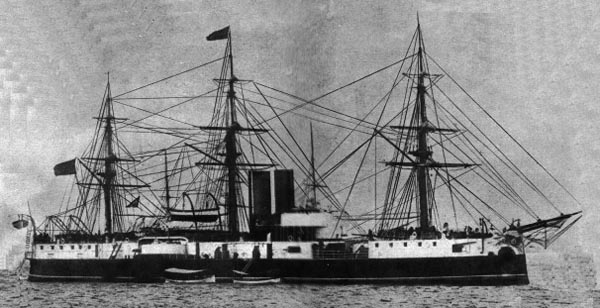
Riachuelo fully rigged, circa 1889
Specifications as built (1885) |
|
| Dimensions | 92.96 x 15.85 x 5.99m (305 x 52 x 19 ft 8 in) |
| Displacement | 5,610 tonnes standard, 6,100 tonnes FL |
| Crew | 367 |
| Propulsion | 2 shafts VCE, 10 Boilers, 7,500 bhp |
| Speed | 16.7 knots (31 km/h; 19.2 mph) |
| Range | Estimated 6000 nm at 10 knots |
| Armament | 4 x 9.2-in/31 (234 mm), 4 x 5.5-in/30 (140 mm), 15 x 1-pdr/40 (37mm), 5 x 14-in TTs. |
| Armor | Belt 178-280 mm, 254 mm main turrets, CT |
The Riachuelo in service (1885-1910)
Name
The battleship was christened after the Battle of Riachuelo in 1865. It opposed the Brazilian and Paraguayan navies, 33 and 18 ships respectively and ended in a decisive Brazilian victory. And it was a riverine battle, on the river Paraguay. After ordering the dreadnought Rio de Janeiro a second ship to be name Riachuelo was ordered in 1914, and of course never built or delivered.
Early years: 1883-91
The Riachuelo took the head of the main battle squadron of the Brazilian Navy as soon as she was in service, and flagship. She was nevertheless the fourth ship to bear that name, after the Paraná River naval battle of June 11, 1865 under the command of Almirante Barroso. Riachuelo was built by the Samuda & Brothers shipyard for £ 365,000 less artillery and ammunition. Supervision was in charge of José da Costa Azevedo. Her keel was laid down on August 31, 1881, she was launched on June 7, 1883, and made ready for fitting out and Armament on July 15, 1884. Captain Eduardo Wandenkolk upon delivery.
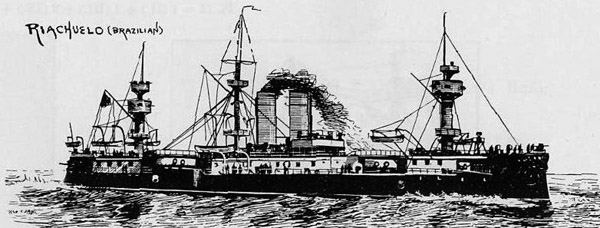
On August 19, 1885, the Squadron was reformed by Notice no. 1541A, written by the then Minister of Navy, Admiral Joaquim Raymundo de Lamare. This new formation was called the Manoeuver Squadron under Squadron commander Arthur Silveira da Mota, Baron of Jaceguai. It was formed of sixteen ships, comprising the Riachuelo, Sete de Setembro, Solimões and Javary, the cruisers Guanabara, Admiral Barroso, Trajano and Primeiro de Marco, 1st Class Torpedoes 1, 2, 3, 4 and 5 and 4th Class Alpha, Beta and Gamma. This Squadron was the most modern task force at the time in the Americas, equipped with ships with the best combination of speed, artillery and torpedoes.
On September 20 1885, Riachuelo left UK and between September 28 and October 22, halted in Lisbon, then departed for Rio de Janeiro, where she arrived on November 13. She joined the new Squadron on November 19, in accordance with the Notice. On August 28, 1884, she became its flagship.
The same year, Riachuelo started exercizes with the new squadron under Admiral Arthur Silveira da Mota. By 1889, November 17, she left Rio de Janeiro, under Captain Lieutenant Alexandrino Faria de Alencar, to escort the liner SS Alagoas, carrying the Imperial Family into exile in Europe after the Proclamation of the Republic. On January 14, 1890, she left Rio de Janeiro for Buenos Aires, carrying the Minister Quintino Bocaiúva, to sign Treaty limits with the Argentine Republic by arbitration of the President of the United States of America, putting an end to the current naval rivalry.
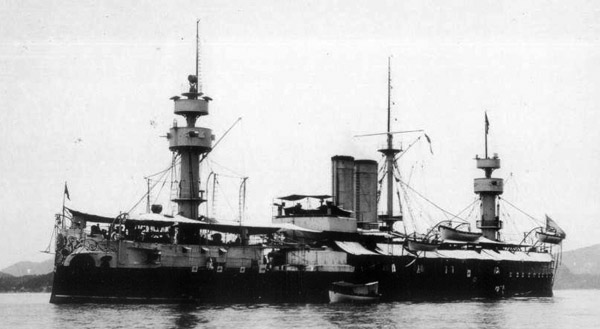
Impact in USN policy
These two battleships placed overnight the Brazilian Navy at the top of the fleets in the western hemisphere. This rang bells at the hite house. Hilary A. Herbert, chairman of the House Naval Affairs Committee was alarmed and immediately recommended to drastically increase naval expenditures. It was time for the “new navy” to build its first battleships. He pushed his cause and rallied supports (including from the Navy) in Congress in 1883.
He declared during a session that “if all this old navy of ours were drawn up in battle array in mid-ocean and confronted by the Riachuelo it is doubtful whether a single vessel bearing the American flag would get into port”.
He stressed the used of at least a similar design of Riachuelo to be studied and built locally. This led to the order of the USS Maine in 1889 (later reclassed as an armoured cruiser) and USS Texas, the first American battleships, launched in 1892. Both were completed in 1895, but in between their conception was already obsolete.
The naval revolt of 1891
The political scene right after the Proclamation of the Republic (1889) was very troubled. This state of affairs worsened after the promulgation of the 1891 Brazilian Constitution. Thus, on the morning of November 3, 1891, the President of the Republic, Marshal Deodoro da Fonseca, closed both houses of the Legislature.
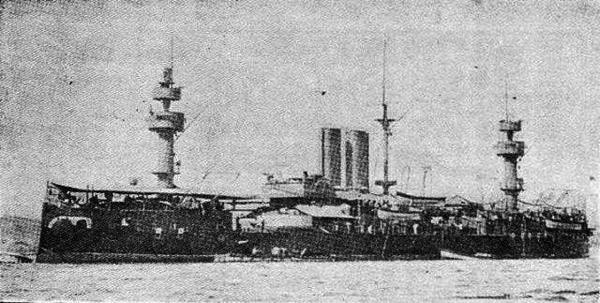
At the time, several officers of the Brazilian Navy conspired to overthrow the dictatorial government that was emerging, led by Admiral Custódio José de Mello, who added a large number of junior officers, scattered in the various naval units based in Rio de Janeiro. Although he was concerned about the delay in the outbreak of the strike, one of the main reasons for this delay was the fact that the two most powerful navy ships – the Riachuelo and Aquidabã – were docked, in repairs.
With the battleship Riachuelo committed to the movement, Custódio de Mello had already drawn up a contingency plan: the movement would start from Cruiser Primeiro de Março, which would be anchored between Ilha das Cobras and Rio de Janeiro’s Navy Arsenal, from where the officers, mostly low-ranking, to take command of the other naval units. Part of the garrison of the First of March would take over the Riachuelo, then proceed to Aquidabã, which had just left the dike; if it resisted, it would be sunk; if it joined the movement, as expected, it would then be towed, as it was still without propulsion, to Ponta da Armação in Niterói in order to protect the existing facilities, which eventually happened.
Marshal Deodoro appointed Captain-de-Mar-e-Guerra Eliezer Tavares to take command of Aquidabã on November 22, soon ordering preparations for combat, but it was still without propulsion and depended on a tug to move . The new commander declared his intention to resist the movement and to sink the Riachuelo if there was resistance from it, but the crew refused to engage in combat. With all his rebellious strength, captained by the battleship Riachuelo, he was preparing for the fighting to come, which was not necessary, because on November 23, 1891 Deodoro resigned, being replaced by Marshal Floriano Peixoto.
Later years: 1892-1910
When the Republic was proclaimed, Riachuelo was under command of Corvette Captain Alexandrino Faria de Alencar. The ship was to escort the steamer SS Alagoas to the Equator, carrying the Brazilian Imperial Family into exile in Europe.
Modernization in France
In 1893 Riachuelo was under Command of CMG João Justino Proença, and by August went to Europe to be modernized in drydock at the Forges et Chantiers de la Mediterranée shipyards, in Toulon. The first step was the replacement of the rigging, and heavy military masts fitted in the fore and last masts instead, with the central mast reduced and kept to manoeuvrer boats.
The engine and armament were also modified (see notes).
Meanwhile, a supplementary contact was signed on June 19, 1894 in Toulon, between the Brazilian Government and chief engineer Claude Goubet, for the construction of a submarine of his patent. As not concerned by the treaty limits, it was Brazil’s attempt to re-establish some preeminence over the Argentines. However the model was rather small, at 8 meter long with a crew composed of an officer and two sailors of Riachuelo, and carried by the latter, as a mothership, as it was done for midget torpedo boats. This project however never came to fruition, due to Goubet’s failure to deliver a working model.
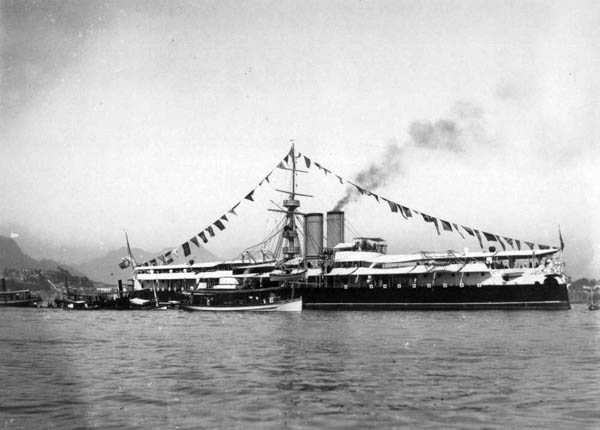
The modernization took the best part of 1895 and 1896, and consisted in several structural reforms, alongside the new armament. The 240 mm guns for example were fast-firing and had a ling range and muzzle velocity. The secondary armament was lighter but fast firing too. She returned to active service as commissioned in 1896, so she missed the entire Second Armada Revolt. The same year she experimented with her new machines in order to evaluate the modernization, reaching 16 knots as delivered by the yard. This performance was praised by the General Staff.
Back to Brazil, she became the flagship of the Squadron again, and in 1900 carried President Campos Sales for an state visit to Argentina. Riachuelo sailed in this occasion with the cruisers Barroso and Tamoyo, called the ‘White Division’ as their hull has been repainted painted in this color for this commission.
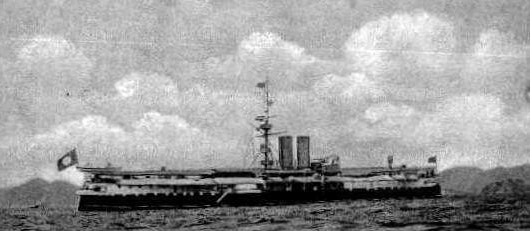
On January 2 1901, the Instruction Division replaced by the 1st Manoeuver Division under Rear Admiral Carlos Frederico de Noronha, composed of the Riachuelo and the Cruisers Barroso, Tupi and Tamoyo. In 1907 Riachuelo took part in the famous Hampton Roads International Naval review in the United States with her Task Group under Rear Admiral Duarte Huet of Bacellar Pinto Guedes.
She would also carry the Brazilian Naval Commission headed by Rear Admiral Huet de Bacellar, in Great Britain to monitor the construction of the new battleships of the 1906 Naval Plan, Minas Gerais and São Paulo. The commissioned also officially took delivery of the ships and crewed them. Due to the arrival of these new capital ships, the Riachuelo was deactivated in 1910. She ws to be sold and broken up in Europe and later was sent to Scotland, by May 14, 1914, Forth Shipbreaking Co. to be dismantled.
Read More/Src:
Gardiner, Robert, ed. (1979) Conway’s all the world fighting ships 1860-1905
Close Encounters of Empire: Writing the Cultural History of U.S.-Latin America
//www.infoescola.com/historia/revolta-da-armada/
//www.naval.com.br/ngb/R/R017/R017.htm
//pt.wikipedia.org/wiki/Cruzador_Protegido_Tamandar%C3%A9
//www.naval.com.br/ngb/T/T002/T002.htm
//pt.wikipedia.org/wiki/Revolta_da_Armada
//en.wikipedia.org/wiki/Brazilian_battleship_Riachuelo
//pt.wikipedia.org/wiki/Encouraçado_de_Esquadra_Riachuelo
//brasilianafotografica.bn.br/?p=10694

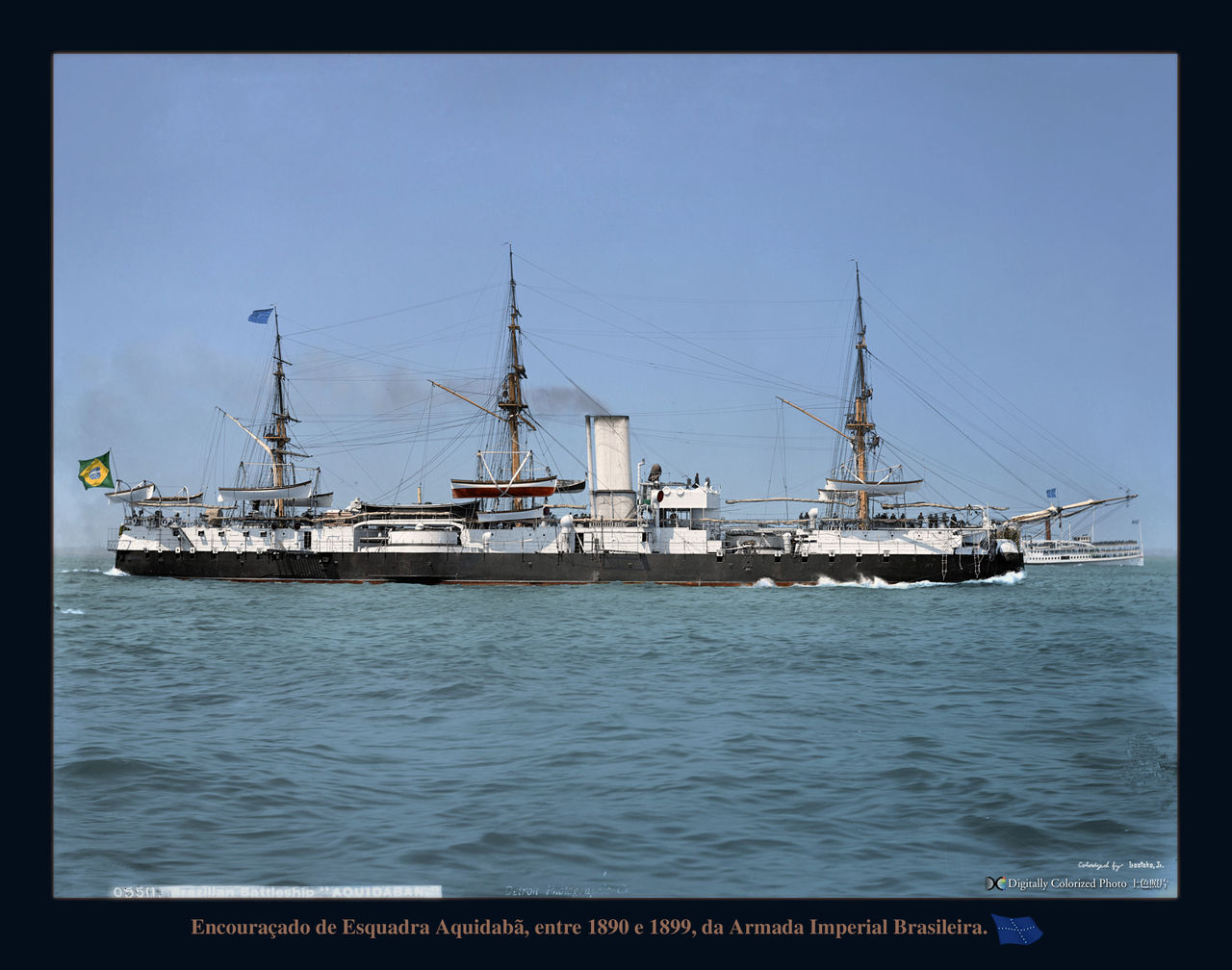

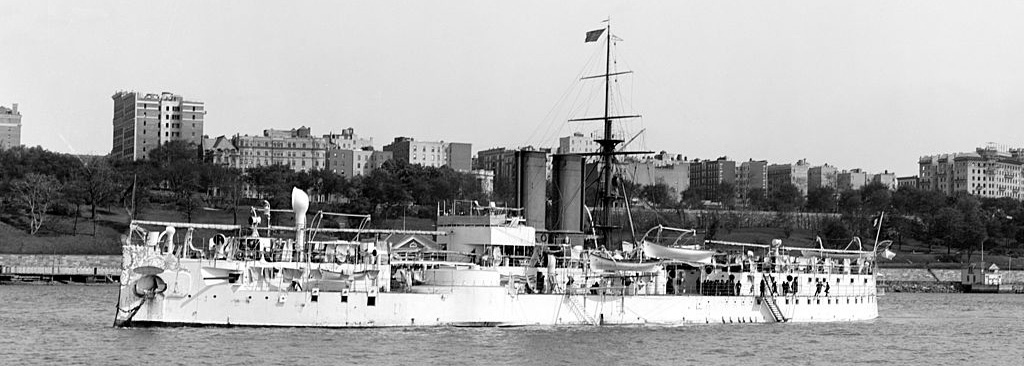
 Latest Facebook Entry -
Latest Facebook Entry -  X(Tweeter) Naval Encyclopedia's deck archive
X(Tweeter) Naval Encyclopedia's deck archive Instagram (@navalencyc)
Instagram (@navalencyc)





 French Navy
French Navy Royal Navy
Royal Navy Russian Navy
Russian Navy Armada Espanola
Armada Espanola Austrian Navy
Austrian Navy K.u.K. Kriegsmarine
K.u.K. Kriegsmarine Dansk Marine
Dansk Marine Nautiko Hellenon
Nautiko Hellenon Koninklije Marine 1870
Koninklije Marine 1870 Marinha do Brasil
Marinha do Brasil Osmanlı Donanması
Osmanlı Donanması Marina Do Peru
Marina Do Peru Marinha do Portugal
Marinha do Portugal Regia Marina 1870
Regia Marina 1870 Nihhon Kaigun 1870
Nihhon Kaigun 1870 Preußische Marine 1870
Preußische Marine 1870 Russkiy Flot 1870
Russkiy Flot 1870 Svenska marinen
Svenska marinen Søværnet
Søværnet Union Navy
Union Navy Confederate Navy
Confederate Navy Armada de Argentina
Armada de Argentina Imperial Chinese Navy
Imperial Chinese Navy Marinha do Portugal
Marinha do Portugal Mexico
Mexico Kaiserliche Marine
Kaiserliche Marine 1898 US Navy
1898 US Navy Sovietskiy Flot
Sovietskiy Flot Royal Canadian Navy
Royal Canadian Navy Royal Australian Navy
Royal Australian Navy RNZN Fleet
RNZN Fleet Chinese Navy 1937
Chinese Navy 1937 Kriegsmarine
Kriegsmarine Chilean Navy
Chilean Navy Danish Navy
Danish Navy Finnish Navy
Finnish Navy Hellenic Navy
Hellenic Navy Polish Navy
Polish Navy Romanian Navy
Romanian Navy Turkish Navy
Turkish Navy Royal Yugoslav Navy
Royal Yugoslav Navy Royal Thai Navy
Royal Thai Navy Minor Navies
Minor Navies Albania
Albania Austria
Austria Belgium
Belgium Columbia
Columbia Costa Rica
Costa Rica Cuba
Cuba Czechoslovakia
Czechoslovakia Dominican Republic
Dominican Republic Haiti
Haiti Hungary
Hungary Honduras
Honduras Estonia
Estonia Iceland
Iceland Eire
Eire Equador
Equador Iran
Iran Iraq
Iraq Latvia
Latvia Liberia
Liberia Lithuania
Lithuania Mandchukuo
Mandchukuo Morocco
Morocco Nicaragua
Nicaragua Persia
Persia San Salvador
San Salvador Sarawak
Sarawak Uruguay
Uruguay Venezuela
Venezuela Zanzibar
Zanzibar Warsaw Pact Navies
Warsaw Pact Navies Bulgaria
Bulgaria Hungary
Hungary

 Bundesmarine
Bundesmarine Dutch Navy
Dutch Navy Hellenic Navy
Hellenic Navy Marina Militare
Marina Militare Yugoslav Navy
Yugoslav Navy Chinese Navy
Chinese Navy Indian Navy
Indian Navy Indonesian Navy
Indonesian Navy JMSDF
JMSDF North Korean Navy
North Korean Navy Pakistani Navy
Pakistani Navy Philippines Navy
Philippines Navy ROKN
ROKN Rep. of Singapore Navy
Rep. of Singapore Navy Taiwanese Navy
Taiwanese Navy IDF Navy
IDF Navy Saudi Navy
Saudi Navy Royal New Zealand Navy
Royal New Zealand Navy Egyptian Navy
Egyptian Navy South African Navy
South African Navy






























 Ukrainian Navy
Ukrainian Navy dbodesign
dbodesign